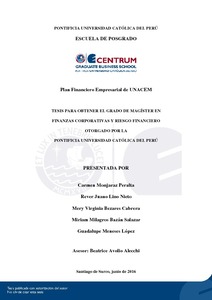| dc.contributor.advisor | Avolio Alecchi, Beatrice Elcira | |
| dc.contributor.author | Monjaraz Peralta, Carmen | es_ES |
| dc.contributor.author | Lino Nieto, Rever Juano | es_ES |
| dc.contributor.author | Bezares Cabrera, Mery Virginia | es_ES |
| dc.contributor.author | Bazán Salazar, Miriam Milagros | es_ES |
| dc.contributor.author | Meneses López, Guadalupe | es_ES |
| dc.date.accessioned | 2017-02-28T15:56:16Z | |
| dc.date.available | 2017-02-28T15:56:16Z | |
| dc.date.created | 2016 | |
| dc.date.issued | 2017-02-28 | |
| dc.identifier.uri | http://hdl.handle.net/20.500.12404/7985 | |
| dc.description.abstract | La industria del cemento está relacionada directamente con el crecimiento del
producto bruto interno (PBI) del sector construcción; situación que es importante para el
sector cementero porque se beneficia cuando el Estado, por medio de las políticas fiscales,
estimula la economía incentivando la construcción. Según los especialistas, la brecha en
infraestructura del país es significativa por lo que la recuperación del sector está asegurada en
cuanto mejore la economía y se dinamicen las inversiones públicas y privadas. Este
escenario de recuperación económica sería más eficiente si se diera en un entorno con menor
corrupción y trabas burocráticas.
El sector cementero peruano es básicamente un oligopolio conformado por los grupos
empresariales: (a) Rizo Patrón, (b) Hochschild, (c) Rodríguez Banda, y (d) Choy; que operan
en distintas regiones del país. Se escogió analizar a la empresa Unión Andina de Cemento
(UNACEM), la cual posee el liderazgo en el mercado, operando en la zona centro del Perú
con dos plantas en Lima y Junín. Además, se elaboró el plan financiero empresarial de la
empresa.
El presente estudio comienza con el análisis del sector cementero en el Perú, en el
cual, el Capítulo I abarca la cuantificación del mercado, el crecimiento, y las tendencias
propias del sector. El Capítulo II se enfoca en el análisis de la empresa elegida (i.e.,
UNACEM), donde se elaboró la valorización de la empresa empleando el método de flujo de
caja descontado a 10 años a la tasa del costo de capital promedio ponderado (WACC, por sus
siglas en inglés). Se obtuvo un costo de capital de los recursos propios (ke) de 14.20%, el
costo de la deuda (kd) fue 4.98%. Así en la valorización, el WACC obtenido fue de 8.15%,
siendo el valor actual neto (VAN) obtenido S/.8,687 millones y el precio de la acción S/.5.28.
El precio de la acción en el mercado al 1 de abril de 2016 fue de S/.2.25. En el Capítulo III
se presenta el plan financiero, donde se plantea el escenario de una mejora en los ingresos
debido a mayor dinamismo en el sector, lo cual es favorable para el valor de la empresa y la
venta de un activo con el fin de mejorar la estructura de capital de la empresa y acercarla al
ratio del nivel óptimo de 40% | es_ES |
| dc.description.abstract | The cement industry is related directly to gross domestic product (GDP) growth of the
construction industry. This correlation is important for the cement industry because it
benefits when the state, through fiscal policy, stimulates the economy by encouraging
construction industry. According to experts the country´s infrastructure gap is significant, so
the recovery of the construction sector is assured as the economy improves along with public
and private investments increase. This scenario of recovery would be more efficient if it
were given with less corruption and bureaucracy.
Peruvian cement industry consists basically of an oligopoly comprised of four
business group operating in different regions of the country: (a) Rizo Patrón, (b) Hochschild,
(c) Rodríguez Banda, and (d) Choy. The chosen company is Union Andina de Cemento
(UNACEM), which holds the first place of the market share. It operates in the central area of
Perú with two factories, in Lima and Junín. In addition, the Business and Financial Plan will
be developed.
The study begins with an analysis of the cement sector in Perú. Chapter I covers the
quantification of the market growth, industry trends and financial analysis. Chapter II focus
on the analysis of the company UNACEM. The valuation of the company was prepared
using the discounted cash flow method for ten years. The cost of capital was 14.24%, the cost
of debt 4.98% and the weighted average cost of capital (WACC) was 8.15%. The net present
value (NPV) was S/.8,687 million and the stock price S/.5.28. The market stock price was
S/.2.25 on 1 April 2016 when the calculations were made. Chapter III contains the Financial
Plan with an scenario of two strategies: (a) organic growth and (b) the sale of an asset in
order to reduce the level of leverage of the company and meet de capital structure with the
optimal ratio of 40% | es_ES |
| dc.language.iso | spa | es_ES |
| dc.publisher | Pontificia Universidad Católica del Perú | es_ES |
| dc.rights | info:eu-repo/semantics/openAccess | es_ES |
| dc.rights.uri | http://creativecommons.org/licenses/by-nc-nd/2.5/pe/ | * |
| dc.subject | Empresas -- Finanzas | es_ES |
| dc.subject | Industria del cemento -- Perú | es_ES |
| dc.title | Plan financiero empresarial de UNACEM | es_ES |
| dc.type | info:eu-repo/semantics/masterThesis | es_ES |
| thesis.degree.name | Maestro en Finanzas Corporativas y Riesgo Financiero | es_ES |
| thesis.degree.level | Maestría | es_ES |
| thesis.degree.grantor | Pontificia Universidad Católica del Perú. CENTRUM | es_ES |
| thesis.degree.discipline | Finanzas Corporativas y Riesgo Financiero | es_ES |
| renati.discipline | 412357 | es_ES |
| renati.level | https://purl.org/pe-repo/renati/level#maestro | es_ES |
| renati.type | https://purl.org/pe-repo/renati/type#tesis | es_ES |
| dc.publisher.country | PE | es_ES |
| dc.subject.ocde | https://purl.org/pe-repo/ocde/ford#5.02.04 | es_ES |






